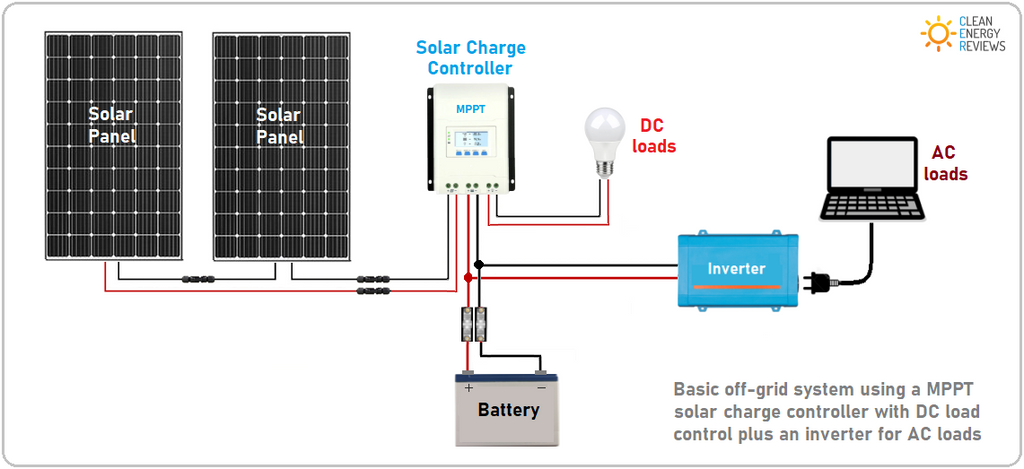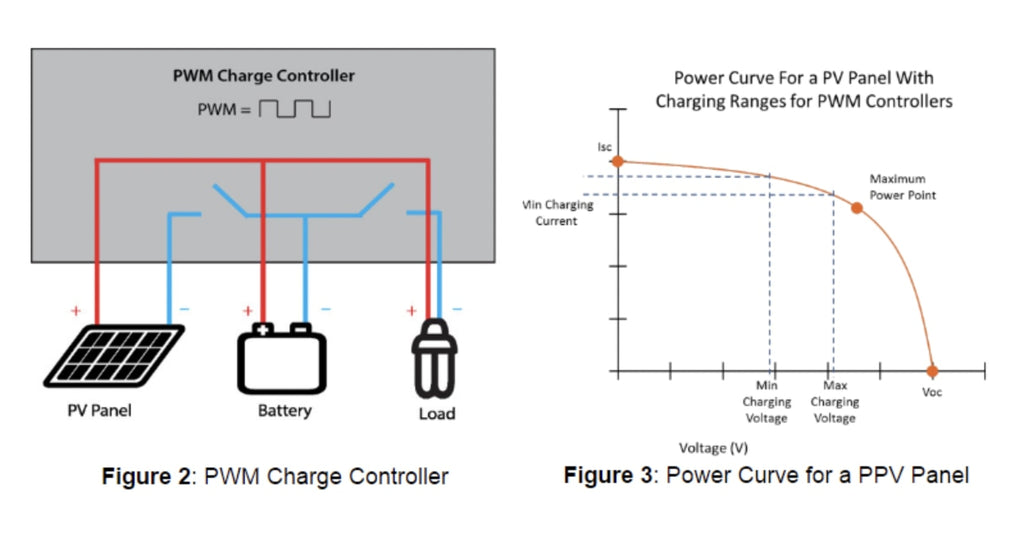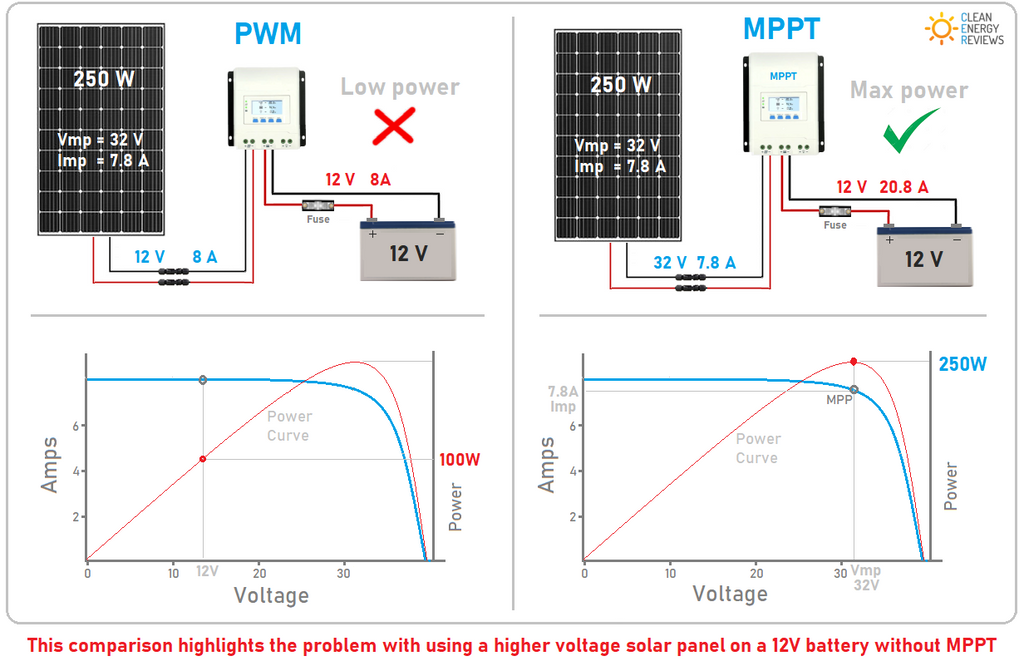
PWM vs. MPPT Solar Charge Controllers
For decades, solar charge controllers have been used in small-scale off-grid and large grid solar systems. A solar charge controller is a solar battery charger connected between solar panels and a battery. It is also known as a solar powered-voltage or solar regulator. Its role is to regulate the battery charging process and ensure it is charged correctly and not overcharged. They are rated according to their current and amp ratings. While the current amp(A) rating gives a maximum charging current, the voltage (v) rating produces a maximum voltage (Voc) of the solar panels.
From eco-conscious landowners to bunker builders, anyone using a solar panel larger than small trickle systems needs some battery regulations which is where the solar charge controllers come in. Charge controllers come in different shapes, sizes, and price ranges. There are two primary charge controllers for solar panels, including the (Pulse Width Modulation) PMW and the (Maximum Power Point Tracking) MPPT. Each type has its purpose, but MPPT is commonly used.
What is an MPPT Charge controller?
An MPPT charge controller is an innovative technology that maximizes the power generated by your solar inverter. This charge controller is embedded with the MPPT algorithm to maximize the amount of current going into the battery from the PV module. The voltage at which a PV module can produce maximum power is called maximum power point or peak power voltage (vpp). The MPPT controllers can handle inclement weather as they will preserve battery input and compensate for low power. They match characteristic internal resistance to the solar panel while drawing on maximum current.
The PV module must apply a voltage higher than the battery to charge effectively. MPPT solar charge controllers are also known as DC-to-DC converters, changing it to an alternating current and converting it back to a direct current. These solar controllers are useful in off-grid solar power systems such as a solar water pump system.

How does an MPPT solar charge controller work?
The tenet of MPPT solar charge controllers takes out the maximum available power from the PV module by making it operate at its most efficient voltage. Usually, it checks the output of the PV module, compares it to the battery voltages, then fixes the appropriate power the PV module can produce to charge the battery. For instance, the current drops to zero if the PV module’s Vpp is slightly below the battery voltage. For efficiency, ideal PV modules like AceVolt Campower 700 are permitted to have up to 200W attached. The potential gradient or voltage difference could be made steeper in two ways.
In other words, if the current is lowered by introducing a resistance, the charge controller can boost up the voltage. It increases the current by about 25% to 30%. The more significant the gap between the panel output and battery voltage, the more the current flows into the battery.

What is a PWM charge controller?
A PWM solar charge controller is an electronic transition between solar panels and batteries. It can achieve constant voltage battery charging by switching the solar system controller’s power devices. They can regulate energy flow to the battery by reducing the current. This process is called “pulse width modulation.” When a battery voltage reaches the regulation setpoint, the PWM algorithm reduces the charging current to reduce the heat and gassing of the battery. The charging continues at a rapid speed while a healthy battery is at its full capacity.
The charge controller is capable of maintaining the system without the added advantage of an MPPT controller. With a PWM controller, the current is drawn regardless of the temperature above the battery voltage. Adopt a panel with a Vmp (maximum power voltage) of around 18V to charge a 12V battery.
How does a PWM solar charge controller work?
A PWM controller works by slowly reducing the power going into your battery as it approaches full capacity. Sensing a control circuitry continuously monitors the battery's environmental conditions and low current to prevent any circulations damaging to the battery. The function blocks of a PWM controller are the internal power supply, PWM circuitry, sensing and control circuitry, and load switch. They are suitable for small DIY solar systems with low voltage panels, and a small battery. During the charging process,
- 1. The switch is on while the charger mode is in bulk charging mode.
- 2. The switch is on and off when required.
- 3. At the end of power absorption, it is off when the battery decreases to the float voltage.
- 4. The switch is on and off to keep the battery voltage at a float voltage.
Which is better; PWM or MPPT Charge controllers?
|
|
MPPT CHARGE CONTROLLERS | PWM CHARGE CONTROLLERS |
| 1. | MPPT controllers are expensive but give greater flexibility | PWM is cheaper and time-tested but comes with less flexibility and efficiency. |
|
2. |
It allows the solar panel’s array to be of higher voltage than the battery bank. | It requires a match between the panel array’s voltage and the battery bank because it cannot capture excess voltage. |
|
3. |
They provide an increase in charging efficiency up to 30%. | They do not provide you with much efficiency. |
|
4. |
Greater flexibility for system growth. | Limited flexibility for system growth. |
|
5. |
They have more warranty periods. | Their warranty periods are shorter. |
|
6. |
An MPPT controller can operate in warm or hot temperatures and boosts better in cloudy temperatures. | When a PWM controller is deployed in warm or hot climates, it performs well. |
MPPT solar charge controllers are the best because they extract more power from any given solar panel array. A recommended controller is Campower 2000 made by AceVolt. You can attach with 2 sets of AceVolt Portable solar panel 200 to Campower 2000 (which allows 500 watts solar input). With the adjustable set points of the MPPT Charge controller, battery charge for off-grid home solar systems or organizational solar systems can be made accessible. What's more, AceVolt portable solar panels have the highest cell efficiency of up to 24%, which can convert more solar energy.
Do you need an MPPT or PWM solar charger?
When buying a solar charge controller, there are some vital factors to consider
The factors are pointers to your ideal solar charger. While the PWM solar chargers are appropriate for small systems only, the MPPT provides both small and big systems with power. The MPPT solar is the solution of choice to higher power systems for a stable and practical solar charging source due to the overall system costs). The MPPT controller would harvest more power when the solar cell temperature is low (below 45-degrees) or very high (above 75-degrees).
Conclusion
At AceVolt, when we select a particular type of solar charge controller over another, we assess its advantages and merit in the overall system cost. We have the best MPPT charge controllers whose ultimate goal is to power a system efficiently while preserving the health of the battery bank. An MTTP solar charge controller would do a lot better than the PWM solar charge controller. Own an MTTP solar charger today!
Related Product
























Leave a comment